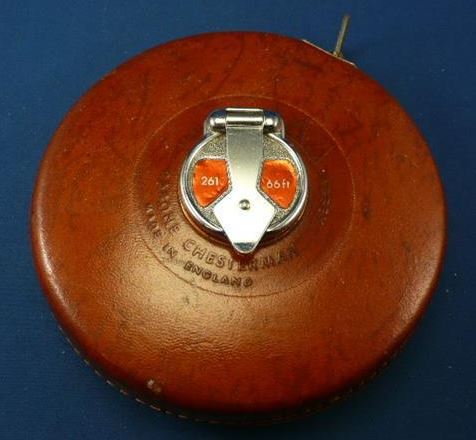The origin of many tools is lost to history. No one knows who invented the first pliers, hammer, axe or screwdriver. It’s hard enough to even find who made the first modern version of many tools. There are a few exceptions, and the tape measure is one of those. Like the folding rule, the invention of the tape measure is recent enough that we have a good amount of information about it.
 One of the first documented tape measures arrived on the scene in 1829 and was patented by James Chesterman. This first tape measure was made of steel and was made from the left over wire that was used for hoop skirts. The fad of hoop skirts lasted only about a decade, so Chesterman was left with flat wire that had no apparent use and his stockpile of metal wire had to go somewhere. Luckily the invention obviously had its uses, or else it would have disappeared with the hoop skirt. Just a few marks on his steel wire made a “measuring chain” that was useful in measuring and lighter than other options at the time.
One of the first documented tape measures arrived on the scene in 1829 and was patented by James Chesterman. This first tape measure was made of steel and was made from the left over wire that was used for hoop skirts. The fad of hoop skirts lasted only about a decade, so Chesterman was left with flat wire that had no apparent use and his stockpile of metal wire had to go somewhere. Luckily the invention obviously had its uses, or else it would have disappeared with the hoop skirt. Just a few marks on his steel wire made a “measuring chain” that was useful in measuring and lighter than other options at the time.
 The tape measure underwent further change in 1868 when Alvin J Fellows filed for a patent in the United States. The Fellows tape measure required some changes to the design of the Chesterman tape measure, so many changes that Fellows was able to argue that he had invented something new rather than just improving on a design. The key innovation that was added in 1868 was the spring action which allowed the tape measure to lock into place and allowed it to retract when the spring was released by a button. This would be the first appearance of the tape measure as we know it.
The tape measure underwent further change in 1868 when Alvin J Fellows filed for a patent in the United States. The Fellows tape measure required some changes to the design of the Chesterman tape measure, so many changes that Fellows was able to argue that he had invented something new rather than just improving on a design. The key innovation that was added in 1868 was the spring action which allowed the tape measure to lock into place and allowed it to retract when the spring was released by a button. This would be the first appearance of the tape measure as we know it.
 As the tape measure gained acceptance, by the 1940s it had found its niche in construction. The tape measure then evolved and gained more features. It became more boxy, gained a belt clip, got a claw on the end of the tape and more. These features have made the tape measure an indispensable tool and one that’s found in every toolbox.
As the tape measure gained acceptance, by the 1940s it had found its niche in construction. The tape measure then evolved and gained more features. It became more boxy, gained a belt clip, got a claw on the end of the tape and more. These features have made the tape measure an indispensable tool and one that’s found in every toolbox.
What started out as a way to use up flat wire left over from the hoop skirt craze evolved into a tool that has largely replaced the folding rule and earned its place in every toolbox. The story of the tape measure is one of those stories of random opportunity resulting in a revolution of the industry. Random stockpiles of flat wire for skirts became one of the iconic symbols of a handyman.

























I have an antique Chase MFG CO NY 25’ tape measure. Can anyone tell me how old it is likely to be? I know it was bought before 1950, but I can’t find any information on the company or when it was manufacturing these.
The information about the hoop “skirts” (in reality, they were petticoats worn underneath skirts) is not correct either, at least as far as the date is concerned. Flat-wire hoops were not generally in use between the 1780s and the 1850s. Once they came into fashion in the mid-1850s, wired undergarments, whether hoops (a.k.a. cage crinolines), crinolettes, or bustles were in use for around 30 years.
This information is not correct. William H. Bangs Jr. received the first patent (#45,372) for a spring return tape measure in the United States on December 6, 1864, four years before Fellows patent. Check the patent records.
Leave a comment